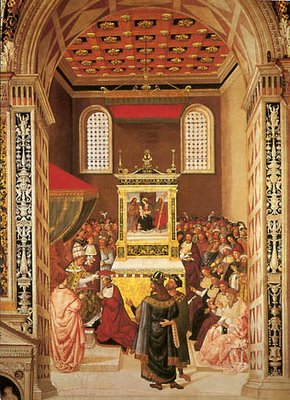THE CONSISTORY: The Protocols
 Oh Good God, this'll be a busy day. But I love it -- I got into all this thanks to a consistory many moons ago, so these events mean as much to me as many of you would consider the births of your children.
Oh Good God, this'll be a busy day. But I love it -- I got into all this thanks to a consistory many moons ago, so these events mean as much to me as many of you would consider the births of your children.In testament to this, I do have a (real) scarlet biretta and zucchetto sitting on my bookshelf, currently in my line of sight. (Both were gifts from Eminent friends.)
So as to avoid confusion, and so you can sound smart at cocktail parties and impress your respective audiences, here is the way the next month runs.
What happened this morning was simply the Pope's announcement of intent to elevate the mentioned prelates to the College of Cardinals -- the names given today are not yet "new cardinals." For obvious reasons, this is done so that the requisite logistical arrangements can be made without fear of indiscretion. The designates were notified of their selections by phone within the last three days.
Even now, though, nothing is set in stone, and Benedict XVI may add to or change the list if he so chooses.
This happened in 2001. On 21 January of that year, John Paul announced his intent to create 37 cardinals a month later, and everyone thought that was it. But given the election of Lubomyr Husar as major-archbishop of Lviv on 26 January, the late Pope then returned to The Window on the following Sunday and announced that Husar would receive the red hat, and six others alongside him (Karl Lehmann among them), bringing the grand total for the 2001 Cardinals' Class to a mind-blowing record of 44. Remember well that, as recently as a decade earlier, the triennial number was half that, and Joseph Ratzinger himself was one of a class of just four cardinals created in 1977 -- the gathering known around town as the "Benelli consistory" because of the man for whom, for all intents and purposes, it was held: the patron of those famous widows (three of whom eventually became cardinals in their own right).
 From today, the honorees may -- in fact, should -- be known as "cardinal-designate" (cardinals are not elected), but everything else waits -- no "Eminence," no reds, none of that -- until the consistory itself. (Gammarelli's strictly-enforced custom is that, aside from the people doing the fittings and the cardinal-designate's secretary, but no one is to see the Eminence-to-be in his new robes until he walks out for the ceremony at which he receives the red hat. Period.)
From today, the honorees may -- in fact, should -- be known as "cardinal-designate" (cardinals are not elected), but everything else waits -- no "Eminence," no reds, none of that -- until the consistory itself. (Gammarelli's strictly-enforced custom is that, aside from the people doing the fittings and the cardinal-designate's secretary, but no one is to see the Eminence-to-be in his new robes until he walks out for the ceremony at which he receives the red hat. Period.)Even in the world of the Vatican, the title "cardinal-designate" is verboten; until the day the biretta is conferred and the names published in consistory, those chosen remain referred to in the episcopal style of "S.E. Mons," with no indicator of their coming status. And if, God forbid, the Pope died before the consistory were held, the designates would not be permitted to enter a conclave and vote as they have not of yet been created and published. Their appointments would effectively die along with the Pope who announced his intentions, and it would be up to a new pontiff whether the wishes of his predecessor would be honored or not.
The Consistory proper, to be held on 24 March, takes place within the context of the Liturgy of the Word, the Pope and all prelates in choir dress. (The cardinals-designate arrive bareheaded and are seated before the papal chair; the existing members of the College sit to the Pope's side.) It features two papal speeches: an exhortation to the new cardinals, and the homily for the worldwide audience.
In times past, there were several consistories for a new incardination of the Roman clergy's honorary, and most prominent, members. First, a secret consistory (in the presence of the existing College) would be held at which the Pope would publish the list of his nominees, conferring on them the style "Eminence" and the right to vote in a conclave. Cardinals-designate resident in Rome would be "notified" of their selection in a ceremony at their proper residences and handed the biglietto, or "ticket," of their nomination. They would then proceed to the semi-public consistory, held in the Papal Apartment, at which they would be given the biretta, followed by the public consistory, usually in the Sistine Chapel, at which the galero -- now abolished as an active item of vesture -- would be conferred. (One cardinal who didn't receive the galero in the 1960s was so infuriated as to tear down his predecessors' hats from his Cathedral ceiling. No lie.)
Since 1988, there has been but one ceremony, and the names have been created and published in a single public consistory. The designees are vested with the zucchetto and biretta toward the end of the rite, after which they greet the entire College individually and then take their places alongside them.
PHOTO: AP/Pier Paolo Cito
-30-

<< Home